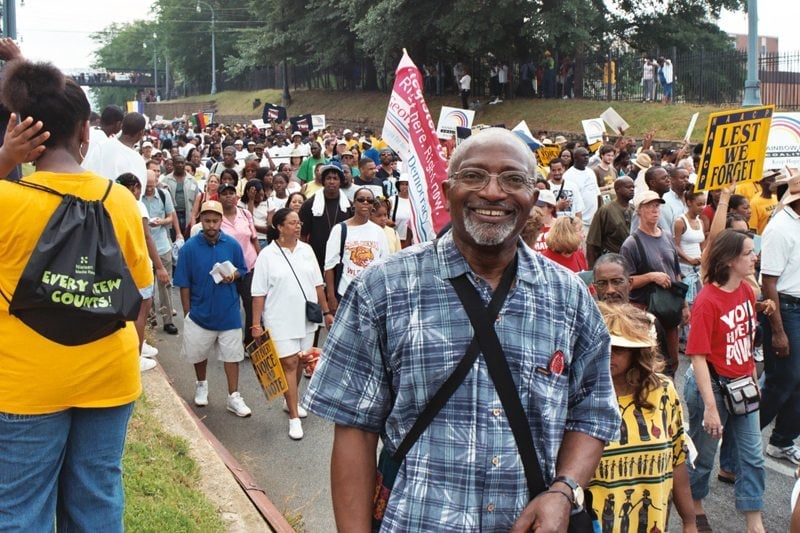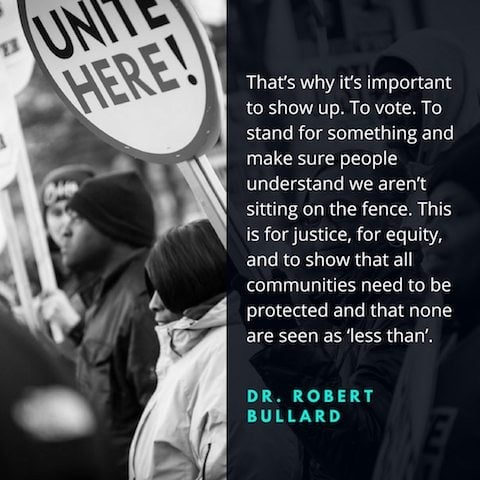An interview with Dr. Robert Bullard
When the father of environmental justice speaks, we listen. That’s why I interviewed Dr. Robert Bullard to hear why race is always the most significant factor behind injustice of any kind, and who he sees as the new leaders pushing equality to the forefront of the environmental movement.

Within the mainstream green movement, there is an important distinction between protecting the environment and attaining equal access to healthy air, water, and land. While communities in both camps often dovetail — sharing similar goals and outcomes — the effects of institutionalized racism and access have forced people of color and marginalized communities to approach environmental advocacy in vastly different ways.
In the 1980’s a new wave of activism began to take shape to address the systemic problem of an environmental movement that, whether consciously or not, had separated the desire to protect the planet from deeply ingrained race and class issues so often exploited by weak environmental protections. Grassroots organizers, taking the cue from the hard-won tactics of the civil rights era, started the environmental justice movement to bridge this divide.
Over the years, these activists have had to fight not only against toxic pollution dumps or the demolition of their neighborhoods for oil refineries —but in many ways, they’ve had to continually reinforce how race is deeply intertwined in these problems and can no longer exist as mutually exclusive efforts. Racism permeates every aspect of society from housing to education; from criminal justice to, of course, the environment. And while many successes and strides have been achieved, there is still much to be done — and learned — as we fight for the protection of the environment for all.
We wanted to unpack some of these issues and who better to help us than Dr. Robert Bullard: the father of environmental justice. As an activist, scholar, and one of the leading crusaders for environmental equality, Dr. Bullard has a thing or two to say about where we’re at as a society, how to be an activist in a complex world, and what’s needed now in the fight for true environmental justice.
Lauren Reid: In your view, why does race matter when we talk about the environment?
Robert Bullard: I think it matters when we deal with the environment because the environment impacts everything— where we live, where we work, where we play, where we learn and where we worship. When certain populations are somehow provided less protection from say pollution, it’s because of race. Or at different times when locally unwanted land use is targeted for different reasons, like refineries and pipelines, it’s because of race and this becomes an issue around justice. Protection should not be distributed because of the color of your skin. Everyone deserves a clean, healthy, sustainable and livable environment.
That’s why race matters.
LR: What do you see as the biggest threat(s) to true environmental justice and equality in the U.S. today?
RB: I think the biggest hurdle we face is to convince policy and decision makers that everyone has a right to live in an environment where laws are applied equally across the board. Look, our society isn’t equal and the people with power or money get more protection — the majority of our population doesn’t live near chemical plants or on the fence line of these dangerous places, so people don’t often believe it when our communities point it out. We’re trying to convince people that environmental justice and racism is real and they don’t realize that until they see if for themselves.
There’s a kind of denial and disbelief in it — There are still people who think you can see all races in the same way when we talk about the environment, but it’s simply not the case. Some communities have the wrong complexion for protection, and that’s not just a bumper sticker.
Textbook case of #environmentalracism: In 46 States, People Of Color Deal With More Air Pollution Than White People Do, Study Finds https://t.co/1NZ97cE7Vk
— Robert D. Bullard (@DrBobBullard) February 28, 2018
LR: Do you see mass action and organizing playing an important role in pushing for lasting change regarding environmental justice? What have you witnessed as some of the most effective ways people have addressed issues of environmental justice in their own communities?
RB: I am a teacher at heart. Teachers have an impact in trying to disseminate information and connect the dots, and our greatest weapon is education. We need to get communities moved to action but having people informed with information and facts, having all those tools in our toolkit to tackle this problem — such as technology, legal, social media, and all those tactics employed in the past, including those from the civil rights movement, are needed. It’s not about adopting one strategy but using the most appropriate technique in the moment to carry environmental justice forward. We need more and different kinds of avenues and hooks to hang the movement on in the future and not be afraid to use them.
Mass protest works because when you hear people say, “we don’t see anyone out there!” the response is that we show lots of people out here protesting — and now with mass media, people can witness a constituency taking the time to voice their opinion and joining in solidarity with others.
That’s why it’s important to show up. To vote. To stand for something and make sure people understand we aren’t sitting on the fence. This is for justice, for equity, and to show that all communities need to be protected and that none are seen as ‘less than’.

Dr. Bullard marching for the reauthorization of the Voting Rights Act in Atlanta, GA 2006. ©Robert Bullard
LR: Are environmental justice efforts more threatened under the new administration, or are these issues so deeply entrenched in the U.S. that other facets of our society currently present greater hurdles?
RB: I think what we’ve seen over the last decades is that environmental justice efforts take two steps forward and one step back. The movement and strategy didn’t come out of the government, it came out of communities that struggled for justice, no matter which administration was in power. Trump is threatening communities on the fence line, including the regulations that have been codified for decades— for example, the Clean Air Act. It’s not black air or Hispanic air—it’s AIR. Dismantling long-standing regulations is not just an issue for people of color, but it will affect a lot of people, and it’s important whenever any government entity attacks the foundation of environmental protection, it’s a moment to circle the wagon and bring us closer together. Bring national and grassroots groups together. With this administration, it’s like anything can be somehow compromised in an effort to please the industry. We need to protect the EPA — we can’t compromise on that, not for our children. Right now, it’s just more in our face, more of a slam dunk but these struggles are much longer than 4 years.
LR: It strikes me that much of the rhetoric in the environmental movement is to address environmental problems in a way that suggests ‘everyone is in the same boat’, struggling to fully recognize how race, along with social and economic injustice, is a fundamental component to environmental disparity. The city of New Orleans is a prime example of this from Hurricane Katrina to now. Have you seen this in your own work and can you speak to a way in which this mentality can be tackled and changed in the future?

RB: I think a lot flows from the fact that race is so intertwined in our society and it’s a difficult topic to talk about— even for progressives and our allies in environmental justice movement. I think we must try to explain why low-income and communities of color get more than their fair share of pollution and to look at race and class as part of this issue — but let’s not reduce everything to poverty. Race trumps class when it comes to pollution. Race was the most powerful factor of why toxic facilities were placed in different areas. Black people are 1 ½ times more likely than whites to be in places with pollution, including the Latino population. How can that be? It’s because racism permeates every aspect of society— housing, parks and playgrounds, education — every aspect. For people who live in communities who don’t have the same environmental challenges, they don’t really understand.
America is segregated and so is pollution. When you try to unpack it, when people suggest, ‘pollution is following poverty, not racism’, it’s wrong. People get dumped on because of the color of their skin, and that is racism. It’s hard to see the nuance, and it’s easy to dismiss race and inequality when talking about the environment. Racism is such an overarching aspect in the U.S. that when you talk about it and point it out, the knee-jerk reaction is often to reference Black Lives Matter and say, ‘we all matter’! But it’s not that no one else matters — it’s that black lives are the ones to deal with police brutality and the criminal justice system. We must do better going forward.
LR: What can be learned from the avenues of change taken during the civil rights movement (i.e. legal, political, mass organizing) that can help inform future environmental justice initiatives in the future?
RB: I think it’s important that we build on previous movements, ones that grew out of civil rights, peace and justice, and student movements. What they all have is a strong youth and student component — they’re the ones that fuel movements. I see more and more young people willing to not allow wedge issues to get in the way, and they converge and work on social justice issues, labor, women’s rights, criminal justice. They all breathe air and eat food, and if they have kids, they don’t want to be playing in a park in the shadow of a refinery.
Our Children's Trust lawsuit gives me hope for a greener future https://t.co/HyKm0U5YhZ via @ncronline
— Robert D. Bullard (@DrBobBullard) February 6, 2018
It’s important to converge in how we redefine the ‘environment’ and bring us all together. It gives me hope, bringing in young leaders that can carry this struggle, this movement, as we face some major existential challenges, like climate change. We will see how this will touch on every progressive movement that goes after justice for all. These young people will come into their own as we settle into another role, whether that be in an advisor or elder role. We need to allow them to do what they know and we need to assist where needed—that’s how we’ll stay focused. I am confident in it.
